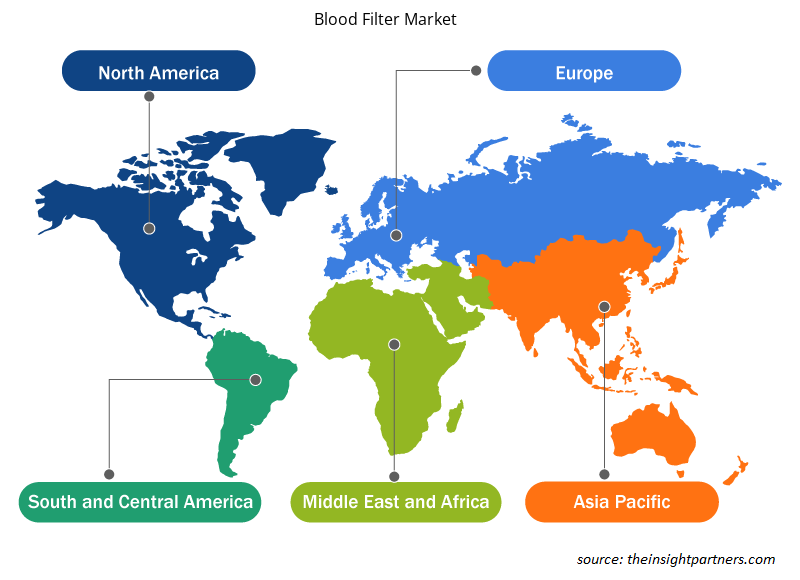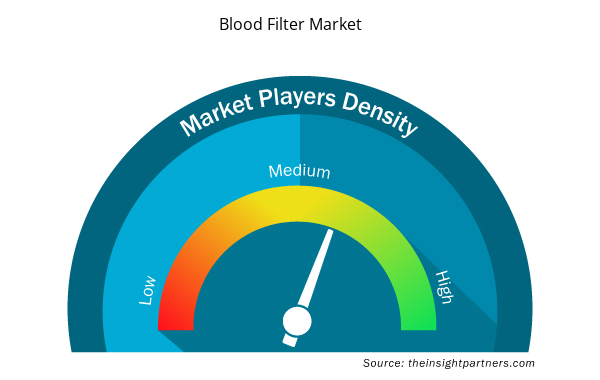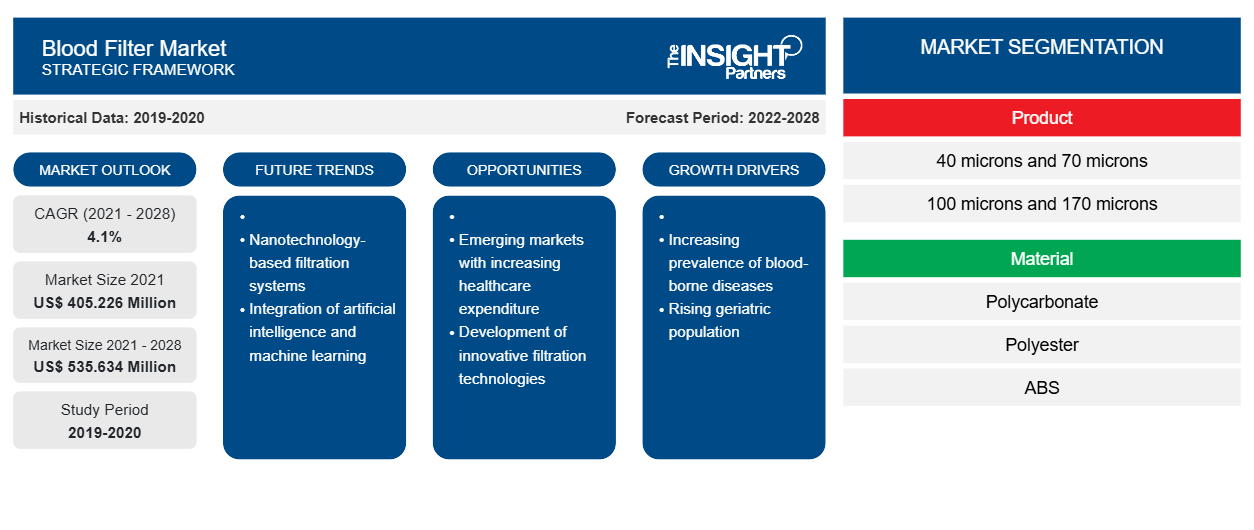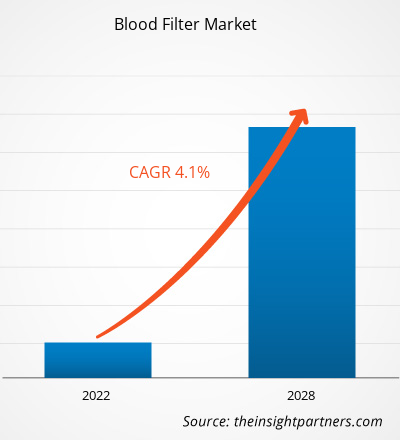من المتوقع أن يصل سوق فلتر الدم إلى 535.634 مليون دولار أمريكي بحلول عام 2028 من 405.226 مليون دولار أمريكي في عام 2021؛ ومن المتوقع أن ينمو بمعدل نمو سنوي مركب قدره 4.1٪ من عام 2021 إلى عام 2028.
مرشح الدم هو مرشح من نوع الشاشة يتكون من شبكة منسوجة مصنوعة من البوليستر أو النايلون، ويتم وضعه بين كيس المنتج والمريض لإجراء الترشيح. تهدف هذه المرشحات إلى حماية المرضى من التجمعات الكبيرة والجسيمات غير المكونة للدم والتي قد تكون خطرة إذا دخلت مجرى الدم. إنها تزيل التجمعات الكبيرة مثل مواقع التجمعات الدقيقة وتجمعات الفيبرين أثناء نقل الدم . تتضمن الترشيح التقاط الجسيمات والتجمعات الكبيرة المكونة من كريات الدم البيضاء والفيبرين والصفائح الدموية، والتي تشكلت أثناء تخزين الدم. عوامل مثل زيادة عبء الأمراض المزمنة، وزيادة حالات الصدمات والحوادث، والعدد المتزايد من إجراءات نقل الدم تدفع نمو سوق مرشح الدم . ومع ذلك، فإن سحب المنتجات يعيق نمو السوق.
قم بتخصيص هذا التقرير ليناسب متطلباتك
ستحصل على تخصيص لأي تقرير - مجانًا - بما في ذلك أجزاء من هذا التقرير، أو تحليل على مستوى الدولة، وحزمة بيانات Excel، بالإضافة إلى الاستفادة من العروض والخصومات الرائعة للشركات الناشئة والجامعات
- احصل على أهم اتجاهات السوق الرئيسية لهذا التقرير.ستتضمن هذه العينة المجانية تحليلاً للبيانات، بدءًا من اتجاهات السوق وحتى التقديرات والتوقعات.
رؤى السوق
ارتفاع عدد عمليات نقل الدم يعزز نمو سوق مرشحات الدم
إن تحسين توافر الدم الآمن والكافي لعمليات نقل الدم يجب أن يكون جزءًا لا يتجزأ من سياسة الرعاية الصحية الوطنية والبنية الأساسية في كل بلد. وقد تنشأ الحاجة إلى نقل الدم في أي وقت في المناطق الحضرية والريفية. في الماضي، أدى عدم توافر الدم إلى وفاة العديد من المرضى الذين يعانون من سوء الصحة. يمكن ضمان إمداد كافٍ وموثوق به من الدم الآمن من خلال وجود مرافق مستقرة للمتبرعين بالدم المنتظمين والطوعيين وغير المدفوعين. وهم أيضًا أكثر مجموعة من المتبرعين أمانًا حيث أن انتشار العدوى المنقولة بالدم هو الأقل بين هؤلاء المتبرعين.
تشمل العمليات الجراحية الأكثر شيوعًا التي تتطلب نقل الدم الإجراءات القلبية الوعائية، وإجراءات الولادة القيصرية، والإصابات. وفقًا لتقديرات المعهد الوطني للقلب والرئة والدم، والمعاهد الوطنية للصحة (NIH)، في الولايات المتحدة، يحتاج أكثر من 5 ملايين شخص إلى نقل الدم كل عام. علاوة على ذلك، بسبب الكوارث الطبيعية والإصابات المنتشرة، يتزايد الطلب على نقل الدم في جميع أنحاء العالم. كما أن الارتفاع في حالات اضطرابات الدم مثل فقر الدم، وزيادة كريات الدم الحمراء، وزيادة كريات الدم البيضاء، وقلة الكريات البيض، وكثرة الصفيحات الدموية يعزز أيضًا نمو سوق مرشحات الدم. وفقًا لمنظمة الصحة العالمية، يولد معظم الأطفال المصابين بالثلاسيميا في البلدان ذات الدخل المنخفض، حيث يكون الوصول إلى نقل الدم صعبًا أو متاحًا لنسبة صغيرة من السكان.
مرشحات الدم المستخدمة في إجراءات نقل الدم عبارة عن شبكة منسوجة مصنوعة من البوليستر أو النايلون؛ وهي عبارة عن مرشحات من نوع الشاشة توضع بين كيس المنتج والمريض. تم تصميم هذه المرشحات لحماية المرضى من التجمعات الكبيرة الضارة المحتملة مثل الصفائح الدموية وكريات الدم البيضاء وبروتينات الفيبرين والجسيمات غير المكونة للدم. في غالبية البلدان المتقدمة، يتم توفير مرشحات نقل الدم من قبل الحكومات أو البرامج المجتمعية. وبالتالي، فإن توافر المرافق المناسبة للتبرع بالدم والتبرع الطوعي يدفع عدد إجراءات نقل الدم، مما يعزز نمو سوق حشو الدم.
رؤى قائمة على المنتج
بناءً على المنتج، يتم تقسيم سوق مرشحات الدم إلى 40 ميكرون و70 ميكرون و100 ميكرون و170 ميكرون وغيرها. من المتوقع أن تحتل شريحة 100 ميكرون و170 ميكرون أكبر حصة في السوق في عام 2021 ومن المتوقع أن تسجل معدل نمو سنوي مركب أعلى خلال الفترة المتوقعة.
رؤى قائمة على المواد
بناءً على المادة، يتم تقسيم سوق مرشحات الدم إلى البولي كربونات والبوليستر وABS وغيرها. من المتوقع أن يحتفظ قطاع البوليستر بأكبر حصة سوقية بنسبة 35.47% في عام 2021، ومن المتوقع أن يحتفظ بهيمنته خلال الفترة المتوقعة.
رؤى قائمة على التطبيق
بناءً على التطبيق، يتم تقسيم سوق مرشحات الدم إلى معالجة الدم ونقل الدم. من المتوقع أن يحتفظ قطاع نقل الدم بأكبر حصة سوقية بنسبة 73.83% في عام 2021، ومن المتوقع أن يحتفظ بهيمنته خلال الفترة المتوقعة.
رؤى تعتمد على المستخدم النهائي
بناءً على المستخدم النهائي، يتم تقسيم سوق مرشحات الدم إلى بنوك الدم والمستشفيات وغيرها. من المتوقع أن يحتفظ قطاع بنوك الدم بأكبر حصة سوقية بنسبة 47.38% في عام 2021 ومن المتوقع أن يحتفظ بهيمنته خلال الفترة المتوقعة.
تتبنى العديد من الشركات العاملة في سوق فلتر الدم استراتيجيات مثل إطلاق المنتجات، وعمليات الدمج والاستحواذ، والتعاون، وابتكار المنتجات، وتوسيع محفظة المنتجات لتوسيع بصمتها في جميع أنحاء العالم، والحفاظ على اسم العلامة التجارية، وتلبية الطلب المتزايد من المستخدمين النهائيين.
رؤى إقليمية حول سوق مرشحات الدم
لقد قام المحللون في Insight Partners بشرح الاتجاهات والعوامل الإقليمية المؤثرة على سوق مرشحات الدم طوال فترة التوقعات بشكل شامل. يناقش هذا القسم أيضًا قطاعات سوق مرشحات الدم والجغرافيا في جميع أنحاء أمريكا الشمالية وأوروبا ومنطقة آسيا والمحيط الهادئ والشرق الأوسط وأفريقيا وأمريكا الجنوبية والوسطى.

- احصل على البيانات الإقليمية المحددة لسوق فلتر الدم
نطاق تقرير سوق مرشحات الدم
| سمة التقرير | تفاصيل |
|---|---|
| حجم السوق في عام 2021 | 405.226 مليون دولار أمريكي |
| حجم السوق بحلول عام 2028 | 535.634 مليون دولار أمريكي |
| معدل النمو السنوي المركب العالمي (2021 - 2028) | 4.1% |
| البيانات التاريخية | 2019-2020 |
| فترة التنبؤ | 2022-2028 |
| القطاعات المغطاة | حسب المنتج
|
| المناطق والدول المغطاة | أمريكا الشمالية
|
| قادة السوق وملفات تعريف الشركات الرئيسية |
|
كثافة اللاعبين في سوق مرشحات الدم: فهم تأثيرها على ديناميكيات الأعمال
يشهد سوق مرشحات الدم نموًا سريعًا، مدفوعًا بالطلب المتزايد من المستخدم النهائي بسبب عوامل مثل تفضيلات المستهلك المتطورة والتقدم التكنولوجي والوعي المتزايد بفوائد المنتج. ومع ارتفاع الطلب، تعمل الشركات على توسيع عروضها والابتكار لتلبية احتياجات المستهلكين والاستفادة من الاتجاهات الناشئة، مما يؤدي إلى زيادة نمو السوق.
تشير كثافة اللاعبين في السوق إلى توزيع الشركات أو المؤسسات العاملة في سوق أو صناعة معينة. وهي تشير إلى عدد المنافسين (اللاعبين في السوق) الموجودين في مساحة سوق معينة نسبة إلى حجمها أو قيمتها السوقية الإجمالية.
الشركات الرئيسية العاملة في سوق فلتر الدم هي:
- شركة أساهي كاساي
- شركة فريسينيوس كابي ايه جي
- ماكوفارما
- شركة هيمونيتيك
- معلومات عن جنوب أفريقيا
إخلاء المسؤولية : الشركات المذكورة أعلاه ليست مرتبة بأي ترتيب معين.

- احصل على نظرة عامة على أهم اللاعبين الرئيسيين في سوق مرشحات الدم
سوق مرشحات الدم – حسب المنتج
- 40 ميكرون و 70 ميكرون
- 100 ميكرون و 170 ميكرون
- آحرون
سوق فلتر الدم – حسب المادة
- بولي كربونات
- البوليستر
- نظام ABS
- آحرون
سوق مرشحات الدم – حسب التطبيق
- معالجة الدم
- نقل الدم
سوق مرشحات الدم – حسب المستخدم النهائي
- بنوك الدم
- المستشفيات
- آحرون
سوق فلتر الدم – حسب المنطقة الجغرافية
- أمريكا الشمالية
- نحن
- كندا
- المكسيك
- أوروبا
- فرنسا
- ألمانيا
- إيطاليا
- المملكة المتحدة
- إسبانيا
- بقية أوروبا
- آسيا والمحيط الهادئ (APAC)
- الصين
- الهند
- كوريا الجنوبية
- اليابان
- أستراليا
- بقية آسيا والمحيط الهادئ
- الشرق الأوسط وأفريقيا
- جنوب أفريقيا
- المملكة العربية السعودية
- الامارات العربية المتحدة
- بقية الشرق الأوسط وأفريقيا
- أمريكا الجنوبية والوسطى (احتيال)
- البرازيل
- الأرجنتين
- بقية أمريكا الجنوبية والوسطى
نبذة عن الشركة
- شركة أساهي كاساي
- شركة فريسينيوس كابي ايه جي
- ماكوفارما
- شركة هيمونيتيك
- معلومات عن جنوب أفريقيا
- شركة كانيكا
- مختبرات كاواسومي المحدودة
- شركة سفر ايه جي
- شركة شاندونج تشونج باو كانج للأدوات الطبية المحدودة
- نانجينغ شوانجوي للتكنولوجيا الحيوية المحدودة
- التحليل التاريخي (سنتان)، السنة الأساسية، التوقعات (7 سنوات) مع معدل النمو السنوي المركب
- تحليل PEST و SWOT
- حجم السوق والقيمة / الحجم - عالميًا وإقليميًا وقطريًا
- الصناعة والمنافسة
- مجموعة بيانات Excel



Report Coverage
Revenue forecast, Company Analysis, Industry landscape, Growth factors, and Trends

Segment Covered
This text is related
to segments covered.

Regional Scope
North America, Europe, Asia Pacific, Middle East & Africa, South & Central America

Country Scope
This text is related
to country scope.
الأسئلة الشائعة
Global blood filter market is segmented by region into North America, Europe, Asia Pacific, Middle East & Africa, and South & Central America. In North America, The US holds the largest size of the market in this region. Nearly 16 million blood components are transfused each year in the U.S. According to the American Cancer Society, more than 1.8 million people are expected to be diagnosed with cancer in 2020. Many of them will need blood, sometimes daily, during their chemotherapy treatment. Blood products are transfused through intravenous tubing with filters. The filters, which typically have pore diameters of 170 to 260 microns, are used to prevent particulate debris from being administered as well. The trapped material promotes bacterial growth, and the American Association of Blood Banks (AABB) recommends not using a filter for more than 4 hours. The government is also experiencing increasing chronic conditions such as acute kidney injury (AKI), multiple organ dysfunction syndromes, or sepsis. Thus, it is expected that rising incidences of chronic diseases are likely to influence the market's growth. Moreover, the rise in transplant procedures across the United States is expected to increase the blood transfer procedures that require collection units such as tubes, bags, and others. According to the Red Cross Blood Center, 4.5 million Americans require blood transfusion annually.
The blood filter market majorly consists of players such Asahi Kasei Corporation, Fresenius Kabi AG, Macopharma, Haemonetics Corporation, Infomed SA, KANEKA CORPORATION, Kawasumi laboratories. Inc., Sefar AG, Shandong Zhongbaokang Medical Implements Co., Ltd, Nanjing Shuangwei Biotechnology Co., Ltd. among others.
The blood transfusion segment dominated the global blood filter market and accounted for the largest revenue share of 73.83% in 2021
The blood banks segment dominated the global colon blood filter market and accounted for the largest revenue share of 47.38% in 2021.
A blood filter is a screen-type filter composed of woven mesh made from polyester or nylon, and it is placed between the product bag and the patient for performing filtration. These filters are intended to protect patients from macro-aggregates and non-blood component particulate matter that could be hazardous if enter the bloodstream. They remove macro-aggregates such as micro-aggregate sites and fibrin aggregates during a blood transfusion. Filtration involves capturing particles and macro-aggregates made from leucocytes, fibrin, and platelets, formed during blood storage.
Key factors that are driving the growth of this market are an increase in the burden of chronic diseases, a surge in cases of trauma and accidents, and a rising number of blood transfusion procedures are expected to boost the market growth for the blood filter over the years.
The 100micron and 170-micron segment dominated the global blood filter market and held the largest revenue share of 56.80% in 2021.
The polyester segment dominated the global blood filter market and held the largest revenue share of 35.47% in 2021.
Trends and growth analysis reports related to Life Sciences : READ MORE..
The List of Companies - Blood Filter Market
- Asahi Kasei Corporation
- Fresenius Kabi AG
- Macopharma
- Haemonetics Corporation
- Infomed SA
- KANEKA CORPORATION
- Kawasumi laboratories. Inc.
- Sefar AG
- Shandong Zhongbaokang Medical Implements Co., Ltd.
- Nanjing Shuangwei Biotechnology Co., Ltd.
The Insight Partners performs research in 4 major stages: Data Collection & Secondary Research, Primary Research, Data Analysis and Data Triangulation & Final Review.
- Data Collection and Secondary Research:
As a market research and consulting firm operating from a decade, we have published and advised several client across the globe. First step for any study will start with an assessment of currently available data and insights from existing reports. Further, historical and current market information is collected from Investor Presentations, Annual Reports, SEC Filings, etc., and other information related to company’s performance and market positioning are gathered from Paid Databases (Factiva, Hoovers, and Reuters) and various other publications available in public domain.
Several associations trade associates, technical forums, institutes, societies and organization are accessed to gain technical as well as market related insights through their publications such as research papers, blogs and press releases related to the studies are referred to get cues about the market. Further, white papers, journals, magazines, and other news articles published in last 3 years are scrutinized and analyzed to understand the current market trends.
- Primary Research:
The primarily interview analysis comprise of data obtained from industry participants interview and answers to survey questions gathered by in-house primary team.
For primary research, interviews are conducted with industry experts/CEOs/Marketing Managers/VPs/Subject Matter Experts from both demand and supply side to get a 360-degree view of the market. The primary team conducts several interviews based on the complexity of the markets to understand the various market trends and dynamics which makes research more credible and precise.
A typical research interview fulfils the following functions:
- Provides first-hand information on the market size, market trends, growth trends, competitive landscape, and outlook
- Validates and strengthens in-house secondary research findings
- Develops the analysis team’s expertise and market understanding
Primary research involves email interactions and telephone interviews for each market, category, segment, and sub-segment across geographies. The participants who typically take part in such a process include, but are not limited to:
- Industry participants: VPs, business development managers, market intelligence managers and national sales managers
- Outside experts: Valuation experts, research analysts and key opinion leaders specializing in the electronics and semiconductor industry.
Below is the breakup of our primary respondents by company, designation, and region:

Once we receive the confirmation from primary research sources or primary respondents, we finalize the base year market estimation and forecast the data as per the macroeconomic and microeconomic factors assessed during data collection.
- Data Analysis:
Once data is validated through both secondary as well as primary respondents, we finalize the market estimations by hypothesis formulation and factor analysis at regional and country level.
- Macro-Economic Factor Analysis:
We analyse macroeconomic indicators such the gross domestic product (GDP), increase in the demand for goods and services across industries, technological advancement, regional economic growth, governmental policies, the influence of COVID-19, PEST analysis, and other aspects. This analysis aids in setting benchmarks for various nations/regions and approximating market splits. Additionally, the general trend of the aforementioned components aid in determining the market's development possibilities.
- Country Level Data:
Various factors that are especially aligned to the country are taken into account to determine the market size for a certain area and country, including the presence of vendors, such as headquarters and offices, the country's GDP, demand patterns, and industry growth. To comprehend the market dynamics for the nation, a number of growth variables, inhibitors, application areas, and current market trends are researched. The aforementioned elements aid in determining the country's overall market's growth potential.
- Company Profile:
The “Table of Contents” is formulated by listing and analyzing more than 25 - 30 companies operating in the market ecosystem across geographies. However, we profile only 10 companies as a standard practice in our syndicate reports. These 10 companies comprise leading, emerging, and regional players. Nonetheless, our analysis is not restricted to the 10 listed companies, we also analyze other companies present in the market to develop a holistic view and understand the prevailing trends. The “Company Profiles” section in the report covers key facts, business description, products & services, financial information, SWOT analysis, and key developments. The financial information presented is extracted from the annual reports and official documents of the publicly listed companies. Upon collecting the information for the sections of respective companies, we verify them via various primary sources and then compile the data in respective company profiles. The company level information helps us in deriving the base number as well as in forecasting the market size.
- Developing Base Number:
Aggregation of sales statistics (2020-2022) and macro-economic factor, and other secondary and primary research insights are utilized to arrive at base number and related market shares for 2022. The data gaps are identified in this step and relevant market data is analyzed, collected from paid primary interviews or databases. On finalizing the base year market size, forecasts are developed on the basis of macro-economic, industry and market growth factors and company level analysis.
- Data Triangulation and Final Review:
The market findings and base year market size calculations are validated from supply as well as demand side. Demand side validations are based on macro-economic factor analysis and benchmarks for respective regions and countries. In case of supply side validations, revenues of major companies are estimated (in case not available) based on industry benchmark, approximate number of employees, product portfolio, and primary interviews revenues are gathered. Further revenue from target product/service segment is assessed to avoid overshooting of market statistics. In case of heavy deviations between supply and demand side values, all thes steps are repeated to achieve synchronization.
We follow an iterative model, wherein we share our research findings with Subject Matter Experts (SME’s) and Key Opinion Leaders (KOLs) until consensus view of the market is not formulated – this model negates any drastic deviation in the opinions of experts. Only validated and universally acceptable research findings are quoted in our reports.
We have important check points that we use to validate our research findings – which we call – data triangulation, where we validate the information, we generate from secondary sources with primary interviews and then we re-validate with our internal data bases and Subject matter experts. This comprehensive model enables us to deliver high quality, reliable data in shortest possible time.


 احصل على عينة مجانية لهذا التقرير
احصل على عينة مجانية لهذا التقرير